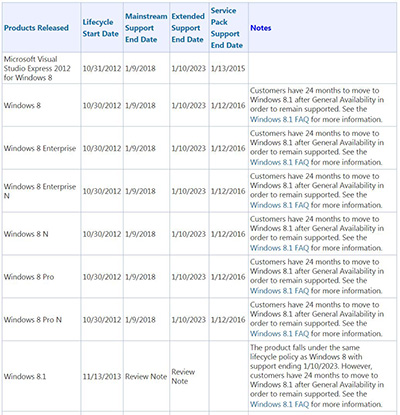News
Windows 8 Is No Longer Supported by Microsoft
Windows 8 lost "extended support" on Tuesday, making the OS more vulnerable to security issues.
Per its policy, Microsoft no longer issues hotfixes or security updates for Windows 8 after the Jan. 12, 2016 end date. The software is considered to be "unsupported" by Microsoft. Exceptions to this policy might be organizations that have purchased Microsoft's "custom support," but that option is thought to be an expensive one, with contracts lasting just a year.
Most organizations likely moved off Windows 8 some time ago, if they ever stopped using Windows 7. Windows 8's release on Oct. 26, 2012 introduced a more mobile oriented kind of operating system, with "desktop" and "Metro" interfaces, but that radical change didn't inspire widespread adoption by businesses. Today, Windows 8 has just a 2.76 percent use rate of all OSes, according to Net Applications' data.
Windows 8's Early Death
Microsoft typically provides a total of 10 years support for its Windows releases, which is divided into a five-year "mainstream support" phase and a five-year "extended support" phase. Consequently, it might be casually thought that Windows 8 had a lot more life to it, and that it hadn't even completed its first mainstream support phase.
But Microsoft changed its terms, leading to an early Windows 8 death. Microsoft's lifecycle support page provides an explanation, but most people likely would be confused by it.
Visitors to the lifecycle support page for Windows 8 will see the following table, which shows extended support end date of Jan. 10, 2023 for Window 8.
 [Click on image for larger view.]
Partial screen capture of Microsoft's lifecycle support policy for Windows 8.
[Click on image for larger view.]
Partial screen capture of Microsoft's lifecycle support policy for Windows 8.
On the face of it, the policy seems to be suggesting that Windows 8 users don't have to move for a long time. However, they have to read the note on the right where Microsoft explains that Windows 8 users have to move to Windows 8.1 two years after the general availability date of Windows 8.1, which happened on Nov. 13, 2013.
Based on that November date, readers of the lifecycle support page might have thought that Windows 8 would have exited extended support on Nov. 13, 2015, but that turns out not to be correct. They have to click on the FAQ link for Windows 8.1 to see Microsoft's statement that the end of extended support for Windows 8 happens on Jan. 12, 2016.
"With the General Availability of Windows 8.1, customers on Windows 8 have 2 years, until January 12, 2016, to move to Windows 8.1 in order to remain supported," the FAQ states.
Nomenclature Shift
This strange death of Windows 8 has an explanation of sorts. At the time, Microsoft was quietly devising a more agile release scenario for Windows in which it would dispense with its traditional "service pack" releases. Service packs were bundles of software fixes. Organizations had 24 months to move to a service pack and still have supported software, which allowed them to continue to receive security updates. Windows 8.1 turned out essentially to be a service pack of Windows 8, but Microsoft didn't use that phrase. It described Windows 8.1 as "similar to how customers deploy service packs," while instituting a 24-month service pack-like policy.
As noted above, though, this extended support end date for Windows 8 didn't exactly track. It should have been Nov. 13, 2015, not Jan. 12, 2016. Did Microsoft arbitrarily extend the date? In response to queries, no answers from Microsoft have arrived.
To add to the confusion, Microsoft issued Windows 8.1 Update on Oct. 17, 2013. Did that release constitute a new service pack that might reset Windows 8's end-of-life date? Apparently not, based on Windows 8's end of extended support date, although a Forbes article seemed to suggest that was a possibility. Moreover, Microsoft's lifecycle support page describes Windows 8 Update as "a cumulative update for Windows 8.1," so it may not have fallen under Microsoft's traditional service pack definition nomenclature. (Confusingly, service packs also are known as cumulative updates.) Back then, Microsoft was in the process of abandoning the meaning of its software update terminology even as it continued to use it.
After the release of Windows 8.1 Update, press rumors had suggested that a Windows 8.1 Update 2 would arrive on Aug. 12, 2014. It's unclear if Update 2 ever did arrive or even if it existed at all. If it did arrive, it's not described in Microsoft's product lifecycle support pages.
Today, Microsoft updates Windows 10 at least monthly, every four months and every eight months. It claims to issue no more service packs for its Windows 10 OS, and all Windows 10 updates are now considered to be cumulative updates. They are big 3GB update deliveries.
Windows 10 was released in July 2015 and it has a mainstream support end date of Oct. 13, 2020, with an end of extended support date of Oct. 14, 2025, per Microsoft's lifecycle fact sheet. For now, organizations can bank on that support timeframe. That is, unless some future "Windows 10.1" release should appear in the interim.
About the Author
Kurt Mackie is senior news producer for 1105 Media's Converge360 group.